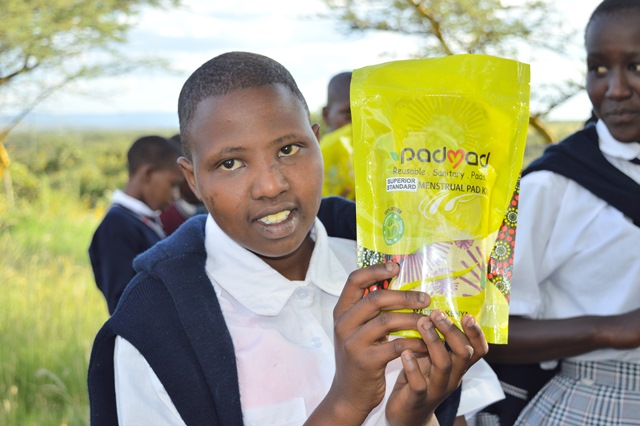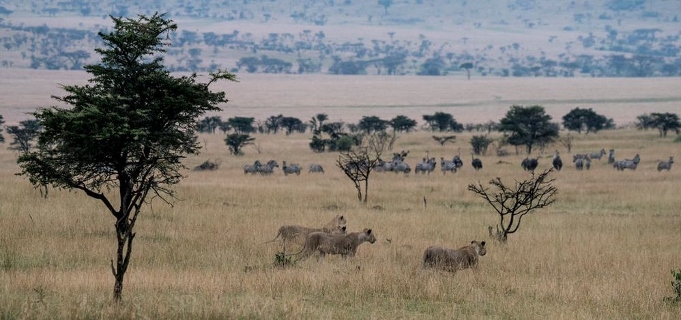
What is it like to observe some of nature’s mightiest predators on a hunt on the African plains? Clinton Richardson finds out …
* * * * * * * * * * * * * * * * * * * * * * * *
This series of blogs will take you on Clinton’s safari in Kenya as he travels from Atlanta (USA) to Nairobi National Park, Selenkay Conservancy (Amboseli), Ol Pejeta Conservancy (Laikipia) and Olare Motorogi Conservancy (Maasai Mara). Let’s join him on his journey as he shares his insights into the conservancies, Porini Camps and the people (and animals!) that he meets along the way. All images are from Clinton’s TrekPic.com photo site. Blog entries are from his Venture Moola blog at ReadJanus.com.
* * * * * * * * * * * * * * * * * * * * * * * *
Just this once, we will ignore the beginning and start near the end with exactly what you would expect from a safari – a hunt. Only this is a photo safari so the hunters will have to be animals. In this case, a pride of 28 lions with a few safari vehicles tagging along.
We are 11 days into a 12-day safari spanning four camps in two national parks and three Maasai conservancies. We know the routine. Up at 5:45 for a 6:15 start with a breakfast packed for a 9:00 to 9:30 break on the plain.
This morning we are in the Porini Lion camp within the Olare Motorogi Conservancy which borders the Maasai Mara game reserve. We hop into our open Land Cruiser at 6:15 a.m. and head out. It is crisp outside with clearing skies. We bundle up. The open air design of the Land Cruiser provides a cold breeze as we drive.
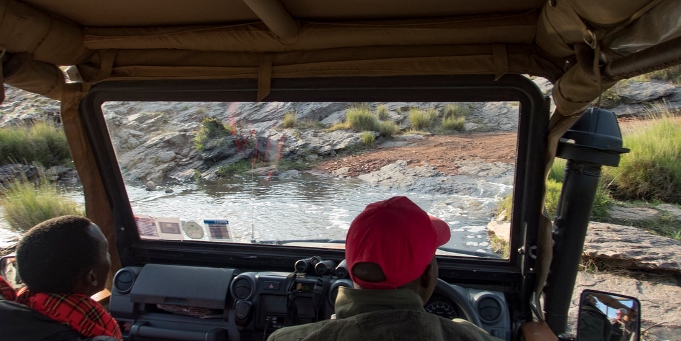
There are four of us today filling six available seats. Our driver and spotter are in front. Both are Maasai and dressed in the bright traditional style of the bush only this morning they wear heavy coats over their bright tunics because of the cold.
There is a certain excitement about starting out each morning (and each afternoon for the second drive). You never know what you will see or where you will see it.
This morning the drive out of camp into the conservancy finds us on wet roads after evening rains. We cross a small stream swollen and muddy from the rain and head into an open grassland. The vehicle slides sideways in the deep mud as we drive down the embankment.
Ahead of us is a gently sloping field with a small herd of topi, all of whom are standing upright and looking in one direction. Across the field is a small stream and then another open field on a gently sloping hill.
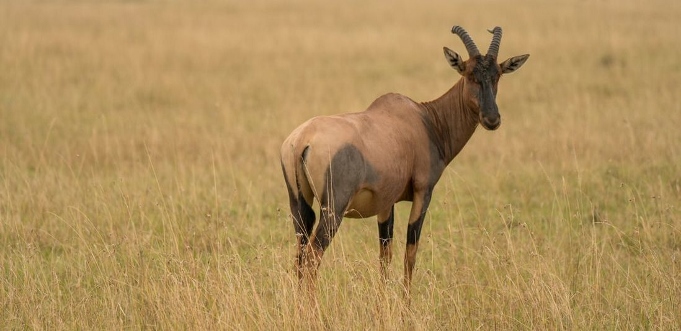
Topi, in more relaxed times
Immediately our driver veers off of the road onto the field with the topi and heads for the stream. As we look across the field, we see lions, lots of lions, dotting the hill on the other side of the stream. They are heading our way. No wonder the topi were attentive.
By the number of brown bodies, our guide knows this is the area’s largest pride. Soon we are at the stream just as the first of the 28 lions reach the other bank.
There is hesitation. They do not like water. Then the first lion jumps over the stream to the other side. Then another and another.
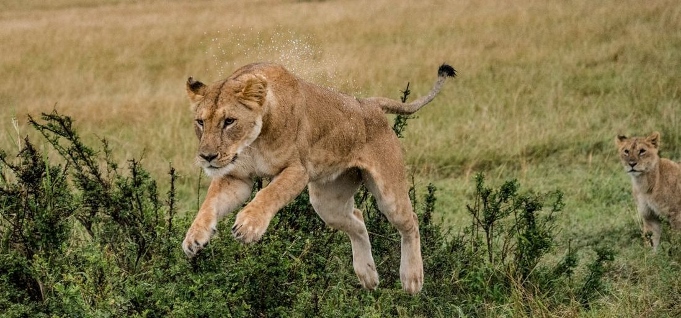
A second line of lions forms a bit upstream and begins their aerial crossing as well. One large female misses her landing and slides back into the stream. She is none too happy as she scrambles up the muddy embankment.
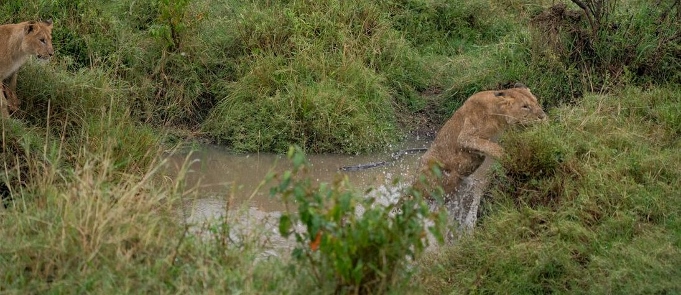
Once the stream is forded, the group heads up the hill on our side. About eight or nine march single file near a dirt path. The rest are spread out into the grass as they proceed in the same general direction. No one is making a sound.

Soon, four or five jackals appear toward the back of the pack, yipping and barking loudly. Occasionally they charge toward the lions only to hurry back when a lion turns its head. They stay close as the pride advances, yipping constantly.
Are the jackals warning the potential prey? Why would they do that when they stand a chance to feed on the leftovers?
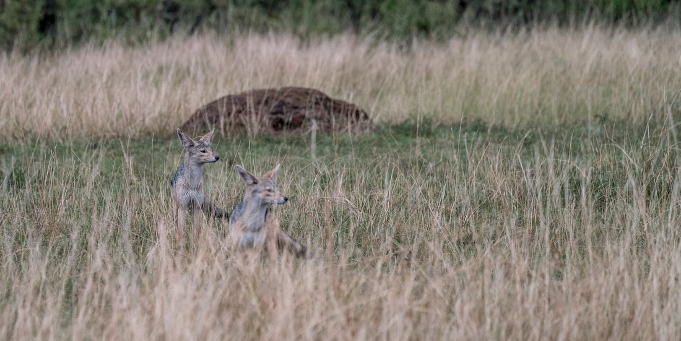
Our vehicle moves with the pride. Sometimes we are slightly behind most of the lions. Other times we move ahead so the procession walks toward and around us. A second vehicle joins us off to the side. The lions are acclimated to vehicles and take little notice.
Some pass right up to our vehicle as they walk by. They are so close you could almost tickle their feet. These are big and powerful creatures who are in control of their environment. When they get close we feel our adrenaline flow.
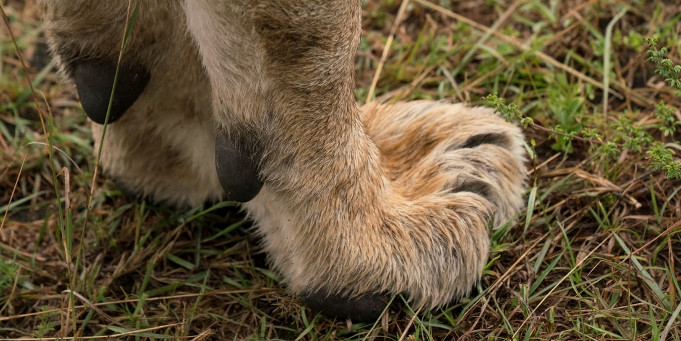
Soon we crest a hill and the lions continue down toward a large open plain. There are trees but they are few and far apart. On the plain is a small herd of zebra.
The lions, all 28 of them, proceed at a leisurely pace down the hill, some move ahead, some spread to the sides and others stop to watch or explore. One youngster carries a bundle of sticks in his mouth as he trots behind the others. Another stops to climb a termite hill.
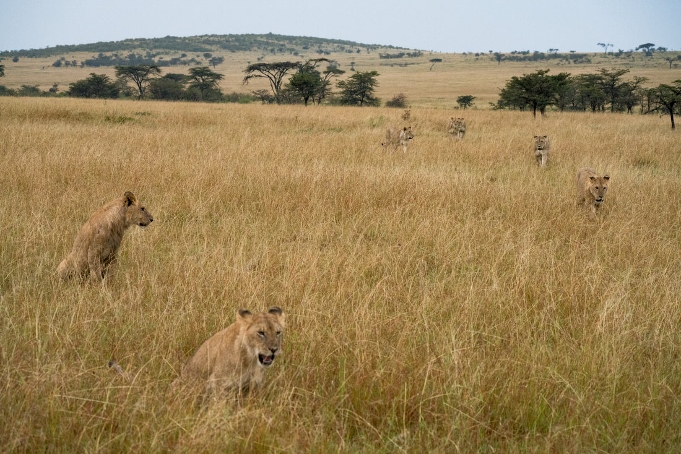
The organization may be unclear but the activity is certainly practiced. Some are clearly father along on the learning curve than others.
As the lions make their way down the hill, the zebras get stiff, then confused. Their ears stand up and heads turn toward the lions. They stop to assess the threat.
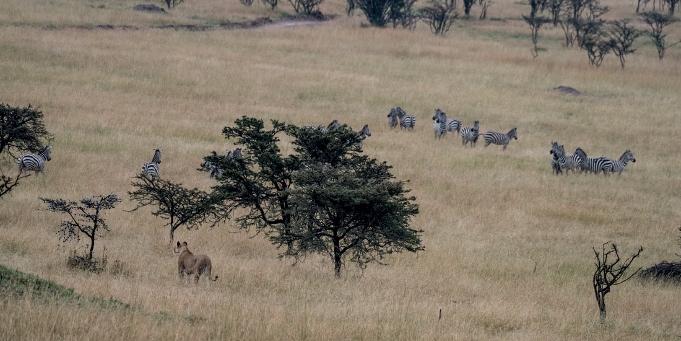
The zebra have now frozen in position
Soon the lions move closer to the zebra. In front, one darts into the center of the herd. The zebras bolt away into two and then four groups. Each is followed closely by a small group of lions. The action stops as the lions take stock of the situation.
We get ready to move on. Our goal was to watch the method, not see the result. As we drive off, I am fixed on a row of seven or eight zebra who are separate from the larger groups and standing bolt upright among a short row of trees. Will they all survive?
Later, after we return to camp, we learn that the zebra were spared that morning. Apparently, an unobservant warthog stumbled into the pack and immediately became breakfast. While the lions were distracted by the kill, the zebras escaped.
It all seems incredible. We not only witnessed this but that we were in the middle of an enormous pride as it happened.
In a few days, I will be at home in Atlanta going through the trip photographs. But just now I am in the middle of the oldest of wildernesses, tamed just enough through familiarity and the lack of human hunting to enable us to experience this extraordinary event.
—–
In the next installment we start our safari in the world’s only wildlife park adjacent to a country capital – Nairobi National Park …
First published 27 Sep 2018. All photos and text are © Clinton Richardson. All images are from his galleries at TrekPic.com
About Clinton Richardson
Clinton Richardson has been writing and taking photographs for decades. His books include the critically acclaimed 5th edition Richardson’s Growth Company Guide 5.0 and the award-winning book about social media and ancient coins called Ancient Selfies. His images, including images taken on his trip, can be viewed at TrekPic.com. His Venture Moola blog can be viewed at Readjanus.com.
See Other Blogs in this Series:
- Safari Countdown: Prepping for Kenya
- Safari 2: Off to Nairobi
- Safari 3: Tented Camps & Conservancies
- Safari 4: Passports In His Underpants
- Safari 5: Night Lions to Amboseli
- Safari 6: Amboseli to Selenkay
- Safari 7: Pooh On You
- Safari 8: Eaten by a Lion?
- Safari 9: The Maasai
- Safari 10: On the Move
- Safari 11: Crash on the Grass
- Safari 12: Sundowner Surprise
- Safari 13: Stalag Panzee
- Safari 14: Bump in the Night
- Safari 15: Dry Season Showers
- Safari 16: How Many Wives Would You Like to Have?
- Safari 17: Distracting His Highness
- Safari 18: How to Eat a Tree
- Safari 19: Hunting with Children (well, cubs!)
- Safari 20: Blue Jean Symphony
- Safari 21: African Nights
on Monday 22nd October 2018 at 04:20




